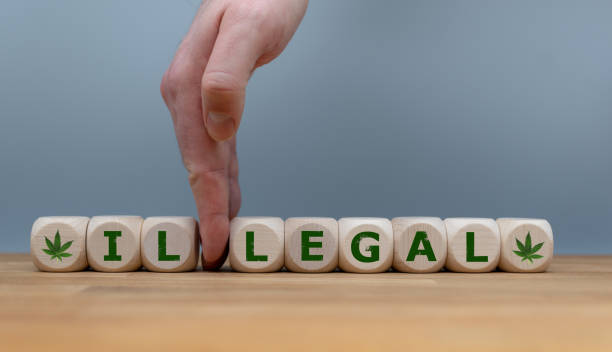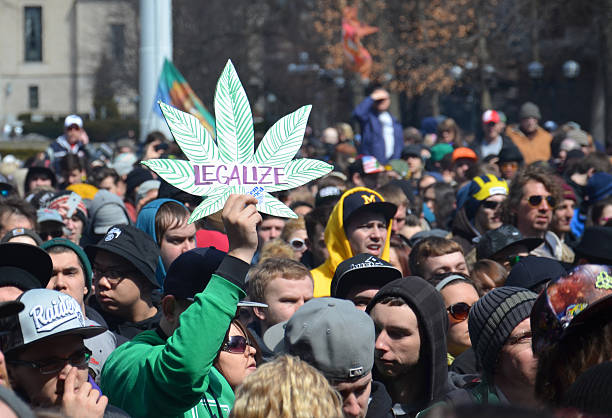Marijuana, weed, cannabis, hemp, and pot have long described a legally frowned upon substance. Fortunately, that perception is quickly fading, partly thanks to the 2018 Farm Bill. For most people, marijuana has long been a substance whose use could get them in trouble. As such, smoking weed is risky because you could end up in jail, but it makes you feel good.
However, weed was not always illegal. In the past, one could access marijuana freely. Moreover, doctors and therapists recommend cannabis use for various ailments. Recreational use was also a thing back then. Therefore, when did marijuana use become illegal? This article explores the history of marijuana and the law, sharing reasons why it became illegal.
The Marijuana Timeline
Let us look at how marijuana came to be seen as a dangerous drug:
17th Century – Hemp Production Kicks Off
Initially, hemp was cultivated for its fiber, which was used to produce ropes, cloth, and sails. However, the Virginia Assembly in 1619 mandated farmers to include hemp in their production. Such production was necessary to supply hemp fiber as a far material during the Civil War.
Marijuana consumption was incidental, but not the first time for it to be used this way. Over time, you could access medical marijuana in dispensaries for medicinal use. Moreover, doctors recommended it for stomach aches, insomnia, inflammation, migraines, and other illnesses. People also soon discovered its recreational properties, but that would take time to become common knowledge.
1906 Pure Food And Drug Act
This consumer protection legislation aimed to control and institute regulations for the safety and welfare of consumers. Furthermore, part of its regulation required full disclosure of the presence of cannabis in any medication or other consumables including weed
1910 – Mexican Revolution
After the Mexican Revolution, Mexican immigrants headed for the US, bringing with them the culture of recreational marijuana use. Consequently, this is when marijuana began receiving a bad reputation. Their presence, use of marijuana, and general dislike of foreigners initiated the prejudice against cannabis. Additionally, the propaganda machine even blamed all terrible crimes on marijuana use.
The 1930s – The Great Depression
This period was probably when marijuana was completely vilified. Moreover, unemployment and poverty made Mexican immigrants and marijuana users an easy target for venting. Research also linked marijuana use to rising crime levels and deviant behavior. Eventually, 29 states outlawed marijuana use.
1932 – Uniform State Narcotic Act
The Federal Bureau of Narcotics, created in 1930 and led by Commissioner Harry J. Anslinger, came up with the Uniform State Narcotic Act that shifted the responsibility of containing marijuana use and associated crimes to the states, not the federal law.
1937- Marijuana Tax Act/Marihuana Tax Act
Following the success of the 1936 propaganda film “Reefer Madness,” Congress passed or enacted the Marijuana Tax Act/Marihuana Tax Act. It thus became illegal for marijuana possession, distribution, or consumption. Also, the Marihuana Tax Act meant that only industries that could pay the tax and demonstrate marijuana’s industrial application could access the plant.For in depth information, refer to What is Cannabis plant?
The 1950s – Federal Marijuana Laws
Federal laws clarified the sentences for drug use, among them marijuana. The Boggs Act of 1952 and Narcotics Control Act of 1956 defined the punishment. For example, you could get between two and 10 years in jail and a fine of up to $20,000 if you were arrested for the first time. Subsequent arrests also had more severe sentences.
1986 – Mandatory Penalties
The 1986 Anti-Drug Abuse Act was the culmination of intense fights between lobbyists that wished to make marijuana use legal and conservatives that sustained the pressure to keep it illegal. In addition, the formation of the US Drug Enforcement Agency (DEA) in 1973 boosted conservative efforts.
Parents also got involved and, with the backing of the DEA, pushed for more stringent sentences. The two to 10 years was not an effective deterrent. Under the Anti-Drug Abuse Act, possession of 100grams of marijuana had similar implications to that of 100grams of heroin or other dangerous drugs. As such, it became the law for repeat offenders to get life sentences and, for major distributors, the death sentence.
Why Was Marijuana Made Illegal In The First Place?
Racism
Whatever other motivation existed for outlawing marijuana use, racism remains the primary reason. The Mexican immigrants after 1910 may have openly used marijuana recreationally, but marijuana use was already the norm in the US. Therefore, marijuana was not the issue but the fear and hate of the immigrants.
Coincidentally, the Great Depression made jobs scarce and life harder. It was easy to blame them for the scarce opportunities. Associating marijuana use and the rising crime levels was escapist and racist. Propaganda spread fear with claims that marijuana use made one act mad.
The name itself was popularized to make cannabis seem foreign. It was commonly known as cannabis until the Mexicans arrived, calling it marihuana. The name marijuana was the anglicized version, further proof of the second-class citizen perception.
Culture And Lifestyle
Marijuana was associated with stoners and potheads; individuals thought to spend most of their days zoned out. That perception of lazy, irresponsible people gave most parents nightmares and reinforced their efforts to fight the drug. Additionally, the association with immigrants and the criminalizing propaganda gave marijuana a bad name. Outlawing the substance was the only logical solution.
Medical Concerns
While not the strongest reason, there was growing various kinds of weed or CBD strains concern that smoking marijuana caused respiratory complications. Those who smoked reported lung inflammation, lung disease, and even reduced pulmonary function. Additionally, one could contract the deadly lung cancer.
Impaired Function
Marijuana use was its own worst enemy here. Most people who used marijuana had impaired judgment of time, distance, and speed. The drowsy state induced by certain strains meant an inability to operate machinery or accidents when you did. Therefore, marijuana withdrawal quickly became associated with such impairment, thus the push to ban it.
Addiction Concerns
Marijuana attained Schedule 1 drug status through the Controlled Substances Act of 1970, partly due to the fear of addiction. While weed is not as addictive as one thought, weed smokers behaved in a way that convinced everyone of its addiction potential.
The Gateway Drug Reputation
Marijuana use also became illegal because it was seen as the first step towards using deadlier and more addictive substances. It was also easy to bundle it with more potent substances like cocaine and heroin as Schedule 1 drugs.
Blanket Claims
Claims that marijuana could cure virtually all diseases further added to skepticism in public and political class sections. Marijuana advocates had no evidence for some of their claims, and some got carried away. Such sentiments jeopardized their cause.
No Scientific Support
Scientists lacked the technology, knowledge, and conviction to fully support claims of marijuana being an amazing substance. It would be decades before scientific research could back some of those claims. Ongoing research exists to fully understand how marijuana interacts with and affects the human body. Imagine the hysteria in 1920.
What’s The Present Situation?
Political efforts, lobbying, and scientific research have helped lessen the stand against marijuana use. More people report positive outcomes from consuming marijuana. Additionally, shifting focus from the prejudices against immigrants, and understanding the racial motivations behind previous legislation, have led to legal reforms. This has resulted in most states embracing marijuana for medical use and some even for recreational use.
The 2018 Farm Bill brought stronger legislative support for marijuana use, specifically hemp. The bill states that growing hemp, the cannabis plant with less than 0.3% THC, is legal.
Additionally, the bill supports such farming with subsidies and such initiatives. Adopting more regulatory oversight on hemp cultivation has greatly helped reshape the public perception and led to safer marijuana use. This way, it is easier to legalize recreational marijuana. You can learn more about where weed is legal ? and how recreational and medical cannabis or medical marijuana laws apply:
Legal Status per State
In the following states, marijuana use is fully legal:
- Alaska
- Arizona
- California
- Colorado
- Connecticut
- District of Columbia
- Idaho
- Illinois
- Kansas
- Maine
- Massachusetts
- Michigan
- Montana
- Nebraska
- Nevada
- New Jersey
- New Mexico
- New York
- North Carolina
- Oregon
- Rhode Island
- South Carolina
- Vermont
- Virginia
- Washington
- Wyoming
These states allow for medicinal use but have not decriminalized marijuana:
- Alabama
- Arkansas
- Florida
- Oklahoma
- Pennsylvania
- South Dakota
- Utah
- West Virginia
These states allow for medicinal use and have decriminalized marijuana:
- Delaware
- Hawaii
- Louisiana
- Maryland
- Minnesota
- Mississippi
- Missouri
- New Hampshire
- North Dakota
- Ohio
These states allow for CBD oil use and have not decriminalized marijuana:
- Georgia
- Indiana
- Iowa
- Kentucky
- Tennessee
- Texas
- Wisconsin
What Does The Future Hold?
Access to more information and the shift in propaganda have led most people to believe that marijuana possesses some unique medicinal qualities. Recreational use is also not that once-feared and vilified experience. Most people believe that marijuana legalization is important for medicinal and recreational use in all states. A small number still believes it should remain outlawed, but the proportion is steadily decreasing.
Most cigarette smokers quit and find cannabis to be a better alternative. Having witnessed the devastating effects of tobacco and no tangible evidence of marijuana’s perceived health challenges, it is an easy choice.
Conclusion: When Did The Weed Become Illegal?
History indicates that marijuana was outlawed unfairly to achieve other agendas. Over the years, marijuana has been cast in a bad light, seen as an evil plant when it contains several vital benefits. As public perception shifts and scientific evidence emerges, marijuana may soon enjoy a more favorable legal status. Marijuana remains a beneficial substance, only if people use it responsibly.






